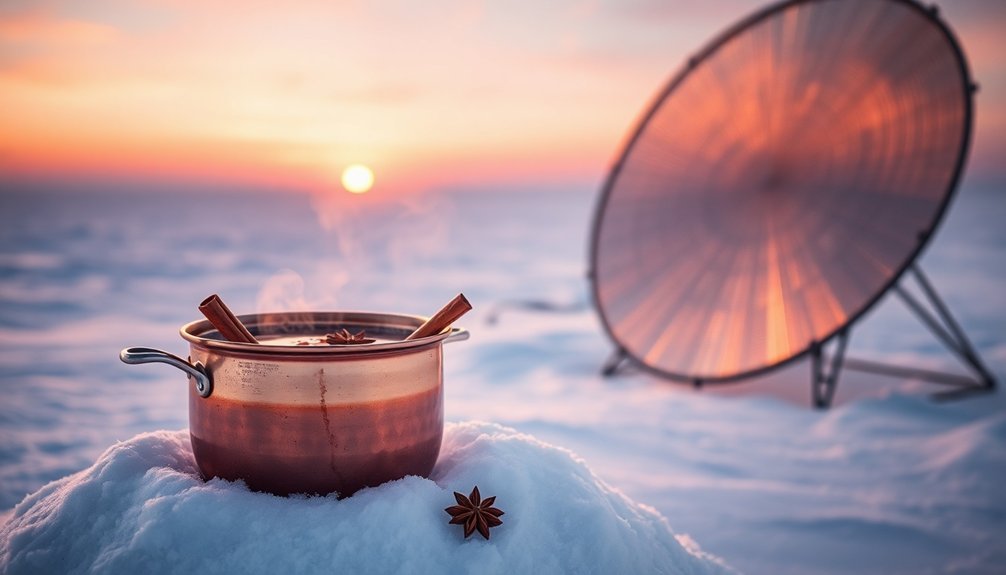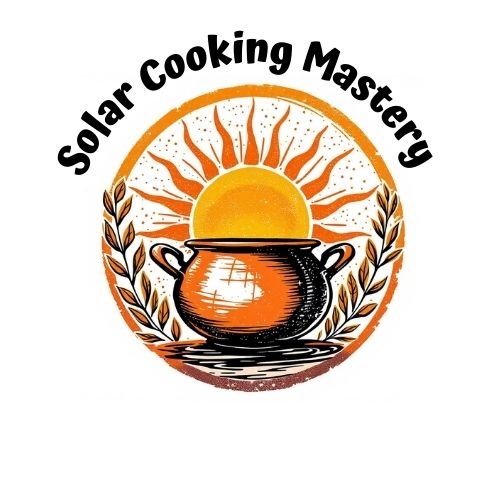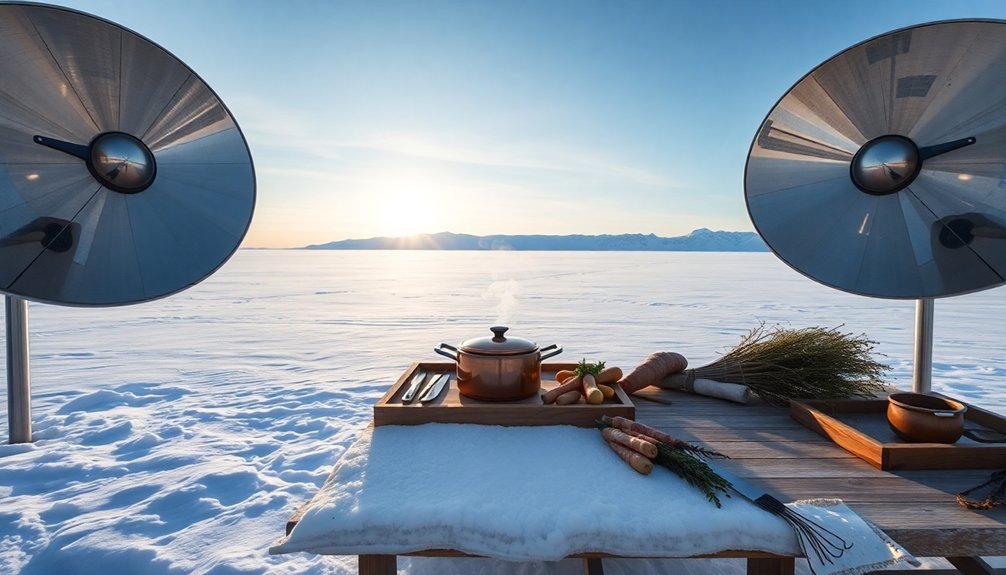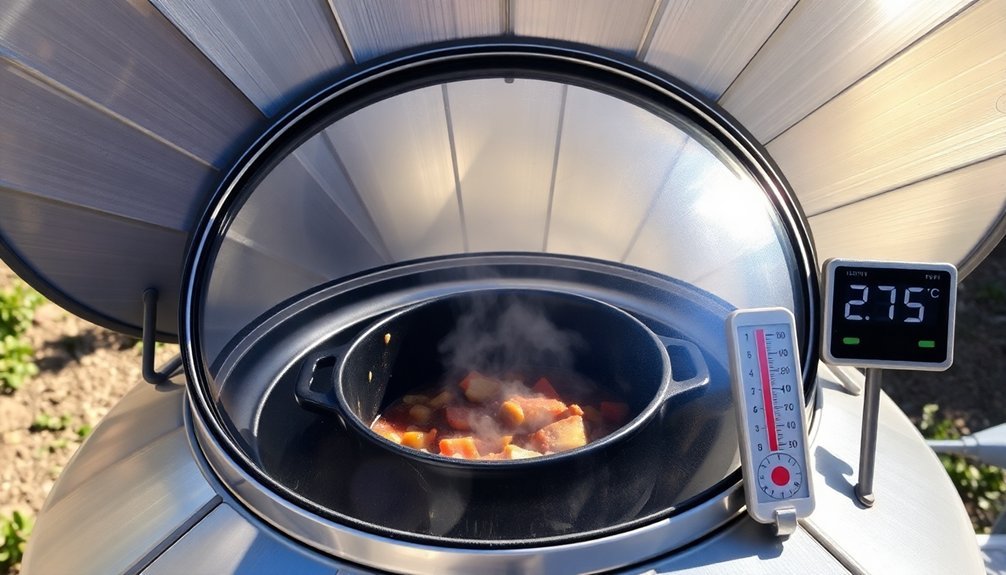Experience the magic of Arctic sun with three remarkable solar-powered recipes. You'll warm your spirits with a festive mulled wine, combining rich red wine with fragrant spices and citrus for the perfect winter drink. Start your day with a hearty Arctic breakfast frittata, featuring buttery Yukon Gold potatoes, smoky bacon, and fluffy eggs that'll fuel your polar adventures. For dinner, you'll create an unexpected fusion with solar tandoori chicken, where traditional Indian spices meet Arctic sunshine for perfectly tender, flavorful results. These sun-kissed recipes will transform your long polar days into a culinary journey worth exploring.
Warming Mulled Wine

Every winter gathering becomes more festive with a steaming pot of mulled wine, a centuries-old beverage that combines red wine with warming spices and citrus.
You'll need a medium to full-bodied red wine like Merlot or Cabernet Sauvignon, along with cinnamon sticks, whole cloves, and star anise. Add sliced oranges and your preferred sweetener, whether it's sugar, honey, or maple syrup. For those seeking variety, white wine base can create an equally delightful alternative.
To prepare, combine all ingredients in a saucepan and heat until barely simmering. Don't let it boil, as this can affect the wine's flavor.
Let it simmer for at least 15 minutes, though you can extend this to three hours for deeper flavors. For extra warmth, add a splash of brandy.
Serve in heatproof mugs, garnished with orange slices and cinnamon sticks.
Arctic Breakfast Frittata
When winter's chill demands a hearty breakfast, this Arctic Breakfast Frittata delivers warmth and satisfaction in every bite. You'll love how the thinly sliced Yukon Gold potatoes create a buttery foundation, while smoky bacon and caramelized shallots add depth to each forkful. The blend of whole milk and eggs creates a silky, rich texture.
Start by roasting your vegetables at 400°F, then reduce to 350°F for the final bake. You'll know it's done when it's perfectly puffed and golden after 20-25 minutes.
| Feeling | Ingredient | Magic |
|---|---|---|
| Comfort | Potatoes | Buttery base |
| Warmth | Bacon | Smoky embrace |
| Joy | Shallots | Sweet surprise |
| Decadence | Cheese | Creamy comfort |
| Satisfaction | Eggs | Golden finish |
Let your creation rest for 10 minutes before slicing. Whether you're fueling up for arctic adventures or enjoying a cozy brunch, this protein-rich dish will keep you energized.
Solar Tandoori Chicken

Through the power of Arctic sunlight, you'll discover a new way to create authentic tandoori chicken without a traditional clay oven. Start by choosing bone-in chicken pieces and making deep slits in the meat.
Mix Greek yogurt with tandoori masala, ginger, garlic, and oil to create your marinade. Let your chicken marinate for up to 12 hours, adding lemon juice just before cooking.
Once your solar oven reaches 300°F, place the marinated chicken in a roasting pan. Cook for 30 minutes, then flip the pieces and continue for another 15 minutes. The dish offers versatile serving options whether you prefer it with rice, hummus, or traditional accompaniments.
Remember to wipe away any moisture from the oven's cover to guarantee proper cooking. Serve your sun-cooked tandoori chicken with naan, mint raita, and garnish with fresh cilantro and red onion slices.
Frequently Asked Questions
Can Solar Cookers Work Effectively During Snowfall or Heavy Cloud Coverage?
No, you won't get effective results using solar cookers during snowfall or heavy cloud coverage. You'll need direct sunlight for proper cooking, as snow and clouds considerably block the sun's rays needed for cooking.
How Do You Prevent Food From Freezing While Preparing Ingredients Outdoors?
You'll need to keep ingredients in insulated containers and work quickly. Use a heated workspace or portable heat source, and don't let items sit out. Keep sensitive ingredients close to your body's warmth.
What's the Minimum Ambient Temperature Required for Solar Cooking in Polar Regions?
You can solar cook in sub-zero temperatures as long as there's direct sunlight. The ambient temperature isn't essential since well-insulated solar ovens create their own microclimate. It's the sun's intensity that matters most.
Do Reflective Snow Conditions Affect Solar Cooking Performance and Timing?
Yes, you'll find that reflective snow greatly boosts your solar cooking performance. It acts like a natural mirror, bouncing extra sunlight into your cooker, which can actually speed up cooking times in winter conditions.
How Long Can Solar-Cooked Food Stay Warm in Sub-Zero Temperatures?
In a well-insulated solar oven, you'll find your food stays warm for 2-3 hours after sunset. You can extend this by using thermal mass materials and keeping the lid tightly sealed during storage.
In Summary
You'll find these sun-powered recipes perfect for taking advantage of the Arctic's long summer days. Whether you're sipping mulled wine under the midnight sun, starting your day with a hearty frittata, or enjoying tandoori chicken cooked by solar heat, you've got sustainable options that honor the unique polar environment. Don't let the absence of night stop you – harness nature's continuous daylight to create these memorable Arctic meals.





Leave a Reply